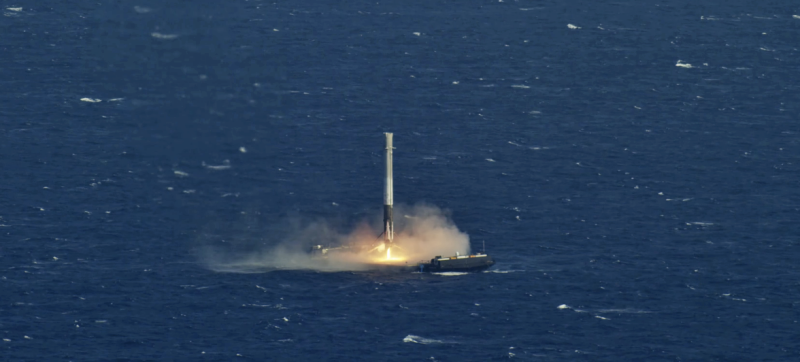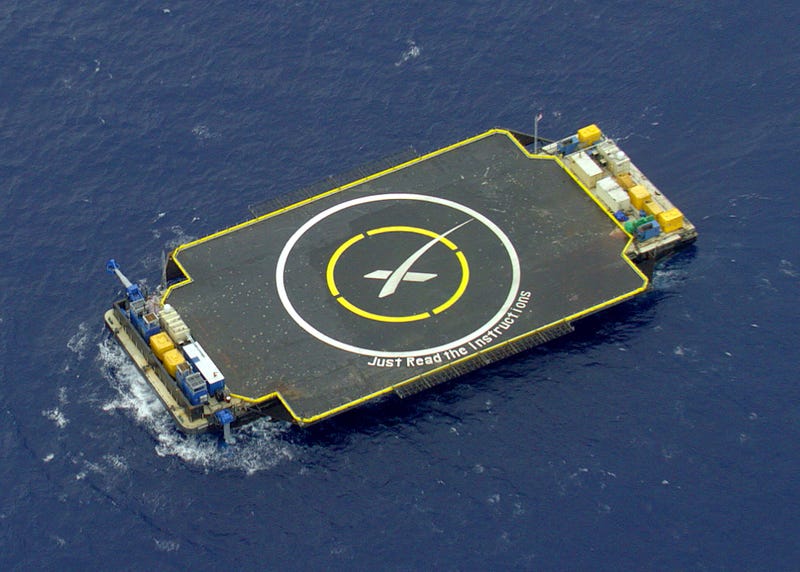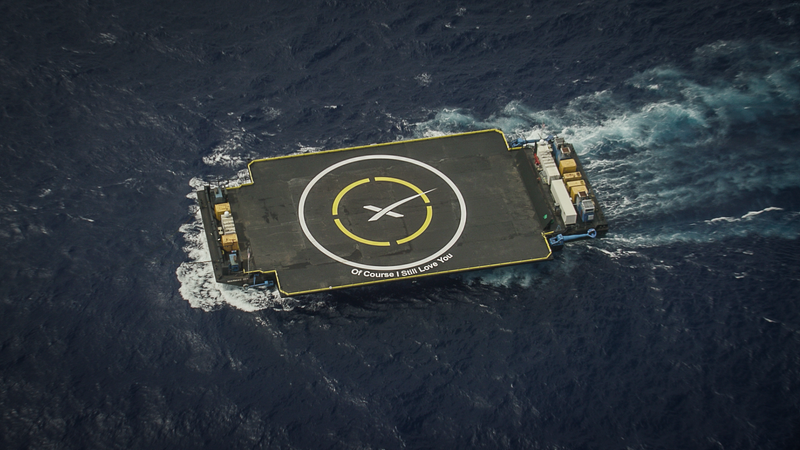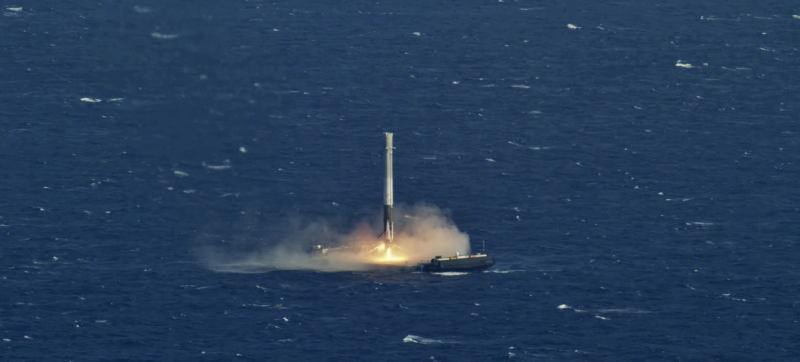
SpaceX finally managed to land its Falcon 9 reusable rocket on its autonomous drone ship out at sea after four unsuccessful attempts, with plans for at least two more sea landings later this year. It takes a special kind of ship to catch a rocket falling from the sky, and here’s how they do it.
http://gizmodo.com/spacexs-falcon…
Elon Musk just had the best week of business in his life after finally successfully landing the SpaceX Falcon 9 rocket engine on a tiny speck of a refitted cargo barge floating in the ocean, in addition to the 325,000 reservations for the Tesla Model 3 electric sedan.
Advertisement
But the riskiest venture of the week was the final moment the Falcon 9 rocket engine returned to Earth after launching an addition to the International Space Station into orbit and, for the first time, managed to land upright on SpaceX’s autonomous landing ship, the wonderfully-named “Of Course I Still Love You.”
It turns out that the landing platforms that SpaceX has developed are just as complicated as literal rocket science.
Sponsored
There have been three separate landing ships developed by SpaceX. The concept of an “Autonomous Spaceport Drone Ship” harks back to Elon Musk’s plans for “creating a paradigm shift in the traditional approach for reusing rocket hardware” in 2009, but the contract for a refitted barge was officially announced in 2014.

The large, flat surface of the ocean barge and the ability to transport heavy payloads are necessary for the high-velocity landings of the Faclon 9 rocket. SpaceX refits the barge platforms with an extended platform measuring 170 feet by 300 feet to facilitate the 18 foot span of the landing legs and the rocket’s support supplies. The first ship featured extended wings and blast walls, but the current models no longer have these features.
According to NASA, these Marmac autonomous drone ships are outfitted with four diesel-powered azimuth thruster engines which can pivot horizontally, removing the need for a ship rudder and offering better maneuverability with a complete 360 degree range of motion for the ship controls. It was originally reported that these thrusters help hold the drone ship position within three meters of accuracy. The engines are supplied by marine equipment manufacturer Thrustmaster.
The materials on the surface of the ship aren’t entirely known, but is likely a thick sheet of steel which prominently features the SpaceX logo.
Advertisement
The drone ships are capable of maneuvering autonomously, using GPS information for precision positioning, but they can also be remotely controlled by an accompanying support ship with a crew of technicians standing by.
A wide array of sensors are used in tandem with the GPS information to manage the “attitude and placement” of the drone ship and communicate with the incoming rocket and the onlooking teams to control and coordinate the complicated precise landings.
Following each landing attempt the crews of the support ship board the drone ship. If the landing is successful, the standing rocket is welded to the deck of the ship and reinforced until it arrives back in port. If the landing was a failure, whatever is salvageable is secured and returned to port.
The Atlantic drone ship returns to the Port of Jacksonville or Port Canaveral in Florida, and the Pacific drone ship docks in the Port of Los Angeles in California.


The first implemented use of SpaceX’s Autonomous Spaceport Drone Ship was in the Atlantic Ocean following a cargo launch to the International Space Station for NASA on January 10th, 2015, which resulted in a failed landing attempt.
Elon Musk claims the liklihood of a successful landing was 50 percent at the most, but recently stated that the odds are closer to 30 percent.
The first drone ship was based on a Marmac series 300 ocean barge, and its name was revealed to be “Just Read The Instructions” after its first test landing.
The first drone ship “Just Read The Instructions” was replaced for Atlantic Ocean duties after six months of operations and two failed test landings at sea.
It’s replacement platform was leased by SpaceX and developed on a much newer Marmac barge, model 304, and as I mentioned earlier, named “Of Course I Still Love You.” Both ship titles are creatively named after autonomously-controlled spaceships from the novel The Player of Games.
A third floating landing platform based on the leased Marmac barge model number 303 was finished in the spring of 2015 and transited the Panama Canal for Pacific Ocean rocket recovery duties. It was later named “Just Read The Instructions” like the first, now retired floating landing platform.
SpaceX has attempted to land the Falcon 9 rocket engine on an autonomous drone ship five times. Two landing attempts in January and April of 2015 resulted in failures after contact with the drone ship, but many stages of the attempts were successful.
The third intended landing attempt was thwarted in June 2015 after the rocket disintegrated before entering the first stage of the landing process.
The first Pacific landing attempting, and fourth total, was conducted in January with a successful “soft landing” of the rocket on the drone ship. However, a catch pin in one of the rocket’s landing legs failed and the rocket toppled over.
The fifth landing attempt on Friday was the first full success in SpaceX’s attempts to land its Falcon 9 rocket engine on a drone ship at sea. This success, and the hope for many more like it in the future, mark the underlying purpose behind SpaceX’s reusable rocket program.
The ability to completely recover an entire rocket body and return it to port to prep for reuse will drastically cut the cost of spaceflight and increase the pace at which payloads and, eventually, humans will be able to access space.
According to Elon Musk at SpaceX’s press conference following the successful landing, eventual use of the drone ships should drop to a quarter of SpaceX return landings with a shift towards land locations for returning rockets. Elon Musk also once tweeted an eventual possibility where the rocket engines land on the drone ship, are prepped and refueled in a rapid turnaround time, and then fly themselves “home.”
Musk also brought up plans for the first manned SpaceX flight by the end of next year with the second generation of the Dragon capsule, with an unmanned test planned first.
“We’ll be successful when it’s boring,” Musk quipped at a question asking him about the next goal following this major success. But he has a point—the realization that this sort of marveling engineering achievement brings us one step closer to casual, inexpensive spaceflight is truly sobering.
The ability for a rocket delivering payloads beyond our atmosphere to communicate and successfully connect with an autonomous floating platform in rocky seas not only breaks the traditional mold of spaceflight recovery, but almost literally jumps from the pages of science fiction.
Here’s to many more successful landing tests at sea and, even more exciting, a successful trajectory for SpaceX’s dreams of putting the first humans on Mars.















